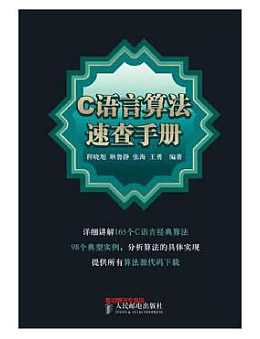为找教程的网友们整理了相关的编程文章,网友步敏智根据主题投稿了本篇教程内容,涉及到C语言、qsort、strcpy、strcat、strcmp、C语言、qsort、C语言、strcpy、C语言、strcat、C语言、strcmp、C语言qsort strcpy strcat strcmp相关内容,已被154网友关注,下面的电子资料对本篇知识点有更加详尽的解释。
C语言qsort strcpy strcat strcmp
1.采用冒泡的方式模拟实现qsort
简述回调函数:
回调函数就是一个通过函数指针调用的函数。如果你把函数的指针(地址)作为参数传递给另一个函数,当这个指针被用来调用其所指向的函数时,我们就说这是回调函数。回调函数不是由该函数的实现方直接调用,而是在特定的事件或条件发生时由另外的一方调用的,用于对该事件或条件进行响应。
模拟实现qsort函数源代码(采用冒泡的方式):
#define _CRT_SECURE_NO_WARNINGS #includevoid swap(void* p1, void* p2, int n) { for (int i = 0; i < n; ++i) { char tmp = *((char*)p1 + i); *((char*)p1 + i) = *((char*)p2 + i); *((char*)p2 + i) = tmp; } } int cmp(const void* elem1, const void* elem2) { return (*((int*)elem1) - *((int*)elem2)); } void Bubble(void* base, int count, int size, int(*cmp)(void*, void*)) { int i = 0; int j = 0; for (i = 0; i < count - 1; i++) { for (j = 0; j < count - i - 1; j++) { if (cmp((char*)base + j * size, (char*)base + (j + 1) * size) > 0) swap((char*)base + j * size, (char*)base + (j + 1) * size, size); } } } void PrintArray(int ar[], int n) { for (int i = 0; i < n; i++) { printf("%d ", ar[i]); } printf("\n"); } void main() { int ar[10] = { 1,3,4,6,2,7,9,8,22,11 }; int sz = sizeof(ar) / sizeof(ar[0]); PrintArray(ar, sz); Bubble(ar, sz, sizeof(ar[0]), cmp); PrintArray(ar, sz); }
2.模拟实现strcpy函数规定
- 源字符串必须以 ‘\0’ 结束。
- 源字符串中的 ‘\0’ 也将会拷贝到。
- 目标空间必须足够大,以确保能存放源字符串。
- 目标空间必须可变。
源代码:
#define _CRT_SECURE_NO_WARNINGS #include#include #include #include char* my_strcpy(char* strDestination, const char* strSource) { //要判断参数的有效性 assert(strDestination != NULL && strSource != NULL); //参数保护 char* pDest = strDestination; while (*strSource != '\0') { *pDest++ = *strSource++; } *pDest = '\0'; return strDestination; } void main() { char str1[20] = "HelloABC"; char* str2 = "Linux"; printf("str1 = %s\n", str1); char* res = my_strcpy(str1, str2); printf("str1 = %s\n", res); }
3.模拟实现strcat函数规定
- 源字符串必须以 ‘\0’ 结束。
- 目标空间必须有足够的大,能容纳下源字符串的内容。
- 目标空间必须可修改
源代码:
#define _CRT_SECURE_NO_WARNINGS #include#include #include #include char* my_strcat(char* strDestination, const char* strSource) { //要判断参数的有效性 assert(strDestination != NULL && strSource != NULL); //参数保护 char* pDest = strDestination; while (*pDest != '\0') pDest++; while (*strSource != '\0') *pDest++ = *strSource++; *pDest = '\0'; return strDestination; } void main() { char str1[20] = "Helloabc"; char* str2 = "Linux"; printf("str1 = %s\n", str1); char* res = my_strcat(str1, str2); printf("str1 = %s\n", res); }
4.模拟实现strcmp函数规定
- 第一个字符串大于第二个字符串,则返回大于0的数字
- 第一个字符串等于第二个字符串,则返回0
- 第一个字符串小于第二个字符串,则返回小于0的数字
源代码:
#define _CRT_SECURE_NO_WARNINGS #include#include #include #include int my_strcmp(const char* string1, const char* string2) { assert(string1 != NULL && string2 != NULL); int res = 0; while (*string1 != '\0' || *string2 != '\0') { //通过减法的方式完成比较 if ((res = *string1 - *string2) != 0) break; string1++; string2++; } if (res > 0) res = 1; else if (res < 0) res = -1; return res; } void main() { char* str1 = "Helloab"; char* str2 = "HelloABCab"; int res = my_strcmp(str1, str2); printf("res = %d\n", res); }
到此这篇关于利用C语言模拟实现qsort,strcpy,strcat,strcmp函数的文章就介绍到这了,更多相关C语言qsort strcpy strcat strcmp内容请搜索码农之家以前的文章或继续浏览下面的相关文章希望大家以后多多支持码农之家!


















